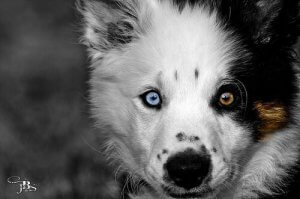Dog Breeds With Two Different Colored Eyes


Written and verified by the lawyer Francisco María García
If your dog has two different colored eyes, there’s no need to worry. Though it might seem strange, this anomaly is simply a result of your pet’s genetic make-up. In fact, there are some breeds that are more prone to developing this trait than others.
It’s important to remember that there are over 400 hundred different dog breeds, without taking into account the different variations that are being discovered every other day, or those that are being designed in laboratories.
In simple terms, the difference in eye coloration is due to a genetic mutation, known as heterochromia. This is a really interesting topic, which all dog owners should be aware of. We’ll tell you all about it in this article.
What is heterochromia?
Scientifically speaking, heterochromia isn’t actually an illness, merely a characteristic. The mutation doesn’t even cause animals any serious problems with their eyesight.

Heterochromia is simply a lack of pigmentation, caused by low levels of melanin. Melanin is the substance which is responsible for skin, hair and, of course, eye color. A dog with two different colored eyes was simply born that way.
There are several different types of heterochromia: partial, complete, and hereditary. As we’ve already mentioned, some breeds are more prone to the condition than others. In this next section, we’ll take a look at some of the different breeds that often have heterochromia.
4 breeds that often have different colored eyes
Perhaps one of the most popular breeds to commonly have heterochromia is the Siberian husky. Experts believe that their origins in the cold Russian steppes may have given them some kind of genetic predisposition to the mutation.
But huskies aren’t the only breeds to have different colored eyes. The American Leopard Hound, the Border Collie, and the Australian Shepherd often have this unusual genetic condition. In these cases, it is all down to the Merle gene, which is directly responsible for passing down the mutation from generation to generation.
Some also believe that breeds with white fur are also more prone to developing different colored eyes than others.
Waardenburg syndrome
Just like humans, animals can suffer from a rare genetic disorder, known as Waardenburg syndrome. However, this phenomenon, which is also closely associated with a lack of pigmentation, is much more common in dogs than in humans.
Dalmatians are one of the breeds most likely to have the condition. It’s no coincidence that these dogs often have different colored eyes, and atypical coat pigmentation. They’re also more likely to be deaf, and have problems with their vision.
Unfortunately, this is an incurable condition, which humans are unable to prevent or control. It’s simply a part of the dog’s individual genetic make-up.
Other breeds that are prone to pigmentation disorders
Breeds which have white and brown coats are more likely to have conditions such as heterochromia and Waardenburg syndrome. For example, it’s common in breeds such as the French Bulldog, and the Pitbull Terrier.
English Cocker Spaniels and Boston terriers are also prone to such conditions. It’s easy to see how these conditions are genetically linked. The majority of affected breeds belong to the same families, such as the terriers or bulldogs.
Dogs with brindle coats are also more likely to suffer from pigmentation disorders than other animals.
Dogs with different colored eyes: when should you be concerned?
In some cases, eyes that were once the same color can actually change. If you notice that your dog’s eyes have significantly changed in color, the best thing to do is take them to the vet for a check-up.

Sudden changes in eye color can be a symptom of glaucoma, a degenerative disease that can cause partial or total blindness. However, in some cases, hereditary heterochromia can actually manifest itself later in life. If you’re ever in any doubt, it’s always best to consult with a vet, who will be able to rule out any serious illnesses.
However, it’s important to remember that heterochromia is a common mutation that affects many different breeds. In most cases, it’s completely harmless.
Canine legends
The existence of dogs with different colored eyes has also been the subject of many myths and legends among ancient civilizations.
For example, Eskimo clans believed that sled dogs with heterochromia were faster than normal dogs. In other cultures, people believe that these dogs had a special connection with spirits in the afterlife.
We hope you’ve enjoyed the article, and here’s another interesting one for you.
If your dog has two different colored eyes, there’s no need to worry. Though it might seem strange, this anomaly is simply a result of your pet’s genetic make-up. In fact, there are some breeds that are more prone to developing this trait than others.
It’s important to remember that there are over 400 hundred different dog breeds, without taking into account the different variations that are being discovered every other day, or those that are being designed in laboratories.
In simple terms, the difference in eye coloration is due to a genetic mutation, known as heterochromia. This is a really interesting topic, which all dog owners should be aware of. We’ll tell you all about it in this article.
What is heterochromia?
Scientifically speaking, heterochromia isn’t actually an illness, merely a characteristic. The mutation doesn’t even cause animals any serious problems with their eyesight.

Heterochromia is simply a lack of pigmentation, caused by low levels of melanin. Melanin is the substance which is responsible for skin, hair and, of course, eye color. A dog with two different colored eyes was simply born that way.
There are several different types of heterochromia: partial, complete, and hereditary. As we’ve already mentioned, some breeds are more prone to the condition than others. In this next section, we’ll take a look at some of the different breeds that often have heterochromia.
4 breeds that often have different colored eyes
Perhaps one of the most popular breeds to commonly have heterochromia is the Siberian husky. Experts believe that their origins in the cold Russian steppes may have given them some kind of genetic predisposition to the mutation.
But huskies aren’t the only breeds to have different colored eyes. The American Leopard Hound, the Border Collie, and the Australian Shepherd often have this unusual genetic condition. In these cases, it is all down to the Merle gene, which is directly responsible for passing down the mutation from generation to generation.
Some also believe that breeds with white fur are also more prone to developing different colored eyes than others.
Waardenburg syndrome
Just like humans, animals can suffer from a rare genetic disorder, known as Waardenburg syndrome. However, this phenomenon, which is also closely associated with a lack of pigmentation, is much more common in dogs than in humans.
Dalmatians are one of the breeds most likely to have the condition. It’s no coincidence that these dogs often have different colored eyes, and atypical coat pigmentation. They’re also more likely to be deaf, and have problems with their vision.
Unfortunately, this is an incurable condition, which humans are unable to prevent or control. It’s simply a part of the dog’s individual genetic make-up.
Other breeds that are prone to pigmentation disorders
Breeds which have white and brown coats are more likely to have conditions such as heterochromia and Waardenburg syndrome. For example, it’s common in breeds such as the French Bulldog, and the Pitbull Terrier.
English Cocker Spaniels and Boston terriers are also prone to such conditions. It’s easy to see how these conditions are genetically linked. The majority of affected breeds belong to the same families, such as the terriers or bulldogs.
Dogs with brindle coats are also more likely to suffer from pigmentation disorders than other animals.
Dogs with different colored eyes: when should you be concerned?
In some cases, eyes that were once the same color can actually change. If you notice that your dog’s eyes have significantly changed in color, the best thing to do is take them to the vet for a check-up.

Sudden changes in eye color can be a symptom of glaucoma, a degenerative disease that can cause partial or total blindness. However, in some cases, hereditary heterochromia can actually manifest itself later in life. If you’re ever in any doubt, it’s always best to consult with a vet, who will be able to rule out any serious illnesses.
However, it’s important to remember that heterochromia is a common mutation that affects many different breeds. In most cases, it’s completely harmless.
Canine legends
The existence of dogs with different colored eyes has also been the subject of many myths and legends among ancient civilizations.
For example, Eskimo clans believed that sled dogs with heterochromia were faster than normal dogs. In other cultures, people believe that these dogs had a special connection with spirits in the afterlife.
We hope you’ve enjoyed the article, and here’s another interesting one for you.
This text is provided for informational purposes only and does not replace consultation with a professional. If in doubt, consult your specialist.








